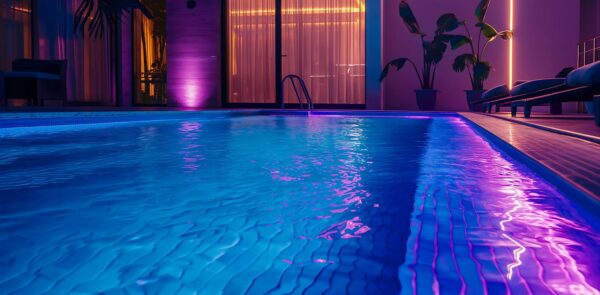
Jump to a section:
Swimming pool companies design, build, and maintain pools for a variety of clients—ranging from homeowners who want a backyard oasis to commercial properties like hotels, resorts, and recreational centers. Some companies specialize in in-ground concrete designs with elaborate features like waterfalls or spas, while others focus on simpler above-ground installations or routine pool service. A well-designed website can help these businesses display their portfolio of completed projects, showcase design creativity, convey technical expertise (like water treatment systems), and streamline inquiries or service requests.
In an industry where visual impact and craftsmanship often drive decisions, a compelling digital presence that highlights before-and-after transformations, custom features, and reliability can be a major differentiator. Pairing strong imagery with functional elements—like scheduling tools, cost estimate forms, or maintenance tips—fosters deeper engagement and helps convert interested browsers into satisfied clients.
Average website design price for swimming pool companies
A custom website for Swimming Pool Companies typically ranges from $4,000 to $15,000 or more, depending on:
- Project scope and portfolio – Some firms only handle standard pool installations, while others offer luxurious custom designs or large-scale commercial builds, requiring extensive photo/video galleries.
- Branding and visual content – High-quality galleries, video tours of completed pools, or 3D design previews can elevate costs.
- Functionalities – Online quote tools, scheduling for pool servicing, subscription-based maintenance packages, or financing integrations.
- Additional services – Some pool companies also provide landscaping, spa installations, or ongoing cleaning/maintenance, needing more detailed site architecture.
Smaller local installers with basic promotional needs could spend near $4,000–$8,000, whereas comprehensive sites featuring interactive design customizers, advanced galleries, and integrated customer portals might be closer to $10,000–$15,000.
Website Design Challenges for Swimming Pool Companies
1. Visually Showcasing Portfolio and Craftsmanship
Pools are highly visual. Prospective clients want to see real examples—pool shapes, tiling choices, water features, lighting, and landscaping integration. Ensuring a site features high-quality, well-organized galleries can be challenging but is crucial for sales.
2. Balancing Cost Transparency and Custom Work
Pool pricing can vary based on materials, size, add-ons (like spas or waterfalls), and site conditions. While clients want at least a rough idea of costs, fully transparent pricing can be tricky given unique project nuances.
3. Handling Multiple Services and Maintenance Plans
Some companies provide only construction, while others offer yearly maintenance contracts, repairs, or chemical supplies. Outlining these offerings in a clear manner helps visitors find relevant information quickly.
4. Seasonal Fluctuations and Lead Management
Demand may spike before summer, or in certain climates year-round. Companies need to capture leads effectively when interest is high and also continue engaging potential clients who are planning for off-season installations or renovations.
5. Education and Safety Considerations
Clients might have questions about pool safety features (fences, covers, alarms), water treatment methods, or design best practices. Websites that address these topics can reassure cautious buyers and reduce phone inquiries.
6. Differentiating in a Competitive Market
Many local installers and large franchises compete on design flair, pricing, or service excellence. Standing out requires a strong brand identity, success stories, or specialized offerings (like saltwater systems, energy-efficient pumps, or infinity-edge designs).
7. Encouraging Clients to Take Action
Buying or renovating a pool is a significant financial commitment. A site must inspire confidence (via proven expertise) and excitement (via visuals/lifestyle content), pushing visitors toward contacting the company for quotes or consultations.
Custom Strategies to Overcome These Challenges
1. High-Quality Portfolio and Galleries
- Before-and-After Sets: Show the transformation of a yard from plain space to a stunning pool area. Include short captions describing challenges solved or special features added.
- Categorized Projects: Sort galleries by style (traditional, modern), budget range, or pool type (in-ground concrete, fiberglass, vinyl liner).
- Video Tours: If feasible, embed short drone footage or walk-throughs, especially for higher-end designs.
2. Offer Pricing Guidance and Ranges
- Package or Example Pricing: Provide “basic pool package starts at $X” or “average custom pool costs $Y–$Z,” with disclaimers about final quotes.
- Custom Quote Forms: Let visitors specify size, shape, material preferences, location constraints, or add-ons (spa, waterfall), generating a more accurate preliminary estimate.
- Financing Options: If you partner with lenders, mention typical monthly payments or interest rates for new pools. This can remove cost-related hesitation.
3. Detail Full Range of Services
- Installation vs. Maintenance Pages: Distinguish new pool construction from renovation, repair, or regular service (cleaning, chemical balancing).
- Seasonal Maintenance: Offer winterizing, spring openings, or year-round care plans. List package inclusions, like weekly vacuuming or monthly inspections.
- Chemical Supply or Store: If you sell pool supplies online, set up an e-commerce section or at least a product catalog.
4. Capture Leads Year-Round
- Email Newsletter: Maintain interest outside peak season with design tips, cost-saving promotions, or off-season installation deals.
- Blog or Resource Articles: Cover topics like “Preparing for Summer Pool Season,” “Saltwater vs. Chlorine Pros and Cons,” or “Landscaping Ideas Around Pools.”
- Follow-Up Automation: If someone requests a quote or downloads a design guide, trigger email follow-ups with helpful info or reminders to schedule a consultation.
5. Educate Clients on Safety and Maintenance
- Safety Section: Summarize recommended safety measures, local code requirements (like fences, gates, or anti-entrapment drains).
- Maintenance Guides: Provide basic chemical balancing tips, weekly checklists, or troubleshooting advice for common issues (pump not priming, algae growth).
- FAQ Pages: Tackle common questions about pH levels, winterizing, or recommended equipment brands.
6. Differentiate With Unique Selling Points
- Design Specialties: Infinity pools, lagoon-style designs, or advanced automation (smartphone-controlled pumps, lighting).
- Eco-Friendly Solutions: Highlight if you offer solar heating, energy-efficient pumps, or natural pool filtration systems.
- Comprehensive Warranty: Emphasize labor or structural warranties, or how you stand by your craftsmanship with robust service policies.
7. Encourage Conversions With CTAs
- Obvious Quote/Consultation Buttons: “Get a Free Consultation,” “Schedule On-Site Assessment,” or “Request a Custom Design.”
- Contact Form Placement: Place forms or CTA banners at logical points—after describing design services, or at the bottom of each project gallery.
- Testimonials: Display short quotes from happy customers praising easy processes, timely completion, or great post-installation support—boosting confidence for new leads.
Implementation Roadmap
- Define Services and Target Pool Types
- Identify whether you focus on in-ground installations, above-ground, renovations, or all. Tailor site navigation and content to reflect these categories.
- If you also handle spas or hot tubs, create separate sub-pages or highlight synergy with pool designs.
- Plan Layout and Visual Content
- Typically: Home, Our Work/Portfolio, Services (Installation, Renovation, Maintenance), About Us, Blog/Resources, Contact.
- Commission or gather professional photos showcasing completed pools at different price points, styles, or features (like spas, lighting).
- Build Key Features
- Photo Galleries or “Projects” page with filters for style, size, or location. Possibly incorporate short videos or 360° panoramas for high-end offerings.
- Quoting/Inquiry forms collecting property location, desired pool style (rectangular, freeform), approximate budget, timeline.
- Possibly e-commerce for chemicals or accessories if that’s part of your business model.
- Testing and Launch
- Check disclaimers about cost estimates not being final until site inspection.
- Validate forms and CTA placements to ensure lead capture.
- Ensure galleries load quickly on mobile for potential clients browsing from their smartphones.
- Maintenance and Ongoing Content
- Update portfolio with newly finished projects. Rotate “featured design” or “customer spotlight” sections to keep the site fresh.
- Publish seasonal advice (like winterizing or energy-saving tips) and new technology announcements in a blog or news feed.
- Encourage customers to share testimonials or photos of them enjoying their new pools, building a sense of community and trust.
Conclusion
For Swimming Pool Companies, a well-designed website is integral to capturing potential customers’ imaginations and guiding them from dream to reality. By effectively showcasing portfolio images, offering transparent service details (including approximate pricing and financing if applicable), and providing user-friendly inquiry forms, businesses can streamline client acquisition and highlight their expertise.
Balancing aspiration (through lifestyle-driven images and successful past projects) with practical resources (like safety guidelines, maintenance tips) helps build trust and fosters long-term relationships. As design trends, materials, and customer expectations evolve, consistently updating and refining the site ensures an innovative, customer-centric experience that keeps prospective pool owners—whether first-timers or seasoned enthusiasts—coming back to plan their next aquatic escape.


